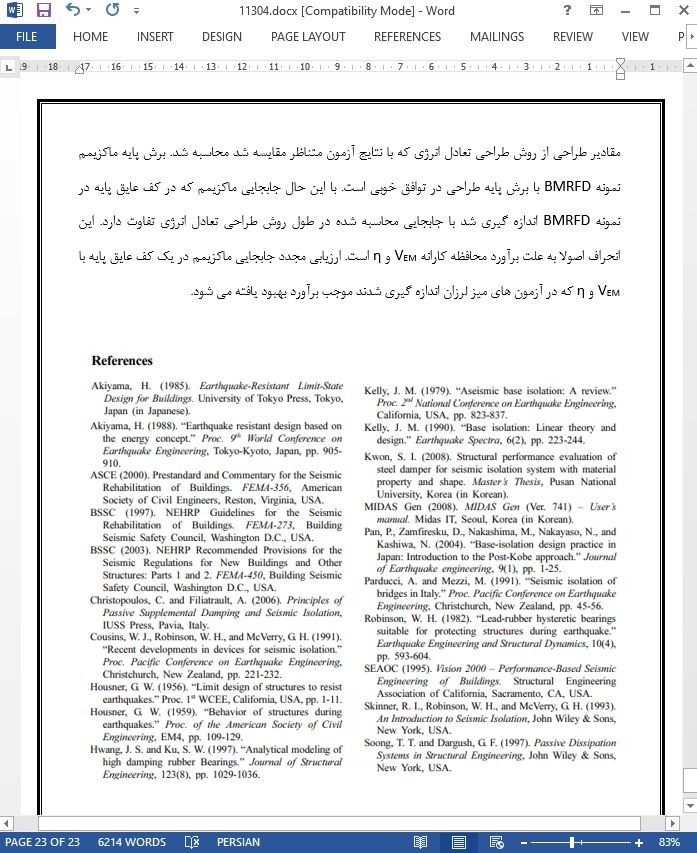
پاسخ لرزه ای مبتنی بر سیستم های عایق با میراگرهای هیسترتیک U شکل
چکیده
این مقاله یک سیستم عایق پایه را برای کاهش مطالبات لرزه ای سازه های افزایشی کم یا متوسط ارائه می دهد و پاسخ آن را با استفاده از آزمون های میز لرزان به صورت آزمایشی بررسی می کند. سیستم عایق پایه بررسی شده در این مقاله شامل روکش لاستیک یاتاقان و میراگرهای هیسترتیک U شکل (UH) است که از فولاد با سختی بالا (HTS) ساخته شده است و برای افزایش ظرفیت تغییر شکل خود با سوراخ های چاک دار ماشین شده است. یک سیستم عایق پایه نمونه 2 طبقه برای آزمون های میز لرزان طراحی شد و آزمون های چرخه ای روکش لاستیک یاتاقان و میراگرهای UH در سیستم های پایه عایق پیاده سازی و سپس اجرا شدند. آزمون جزء برای روکش لاستیک یاتاقان به نوعی سختی جانبی کم با سختی عمودی کافی را برای حمل بارهای گرانش نشان می دهد. نتایج آزمون برای میراگرهای UH نشان می دهد که کاربرد مواد HTS و معرفی جزئیات سوراخ های چاک دار ظرفیت های تغییر شکل را با القای توزیع یکنواخت فشار در طول میراگر UH افزایش می دهد. در نهایت آزمون های میز لرزان که با استفاده از نمونه ها انجام شدند با افزایش شتاب زمین به لرزه می آیند. آزمون میز لرزان نشان می دهد که سیستم عایق پایه مطرح شده با میراگرهای UH مطالبات لرزه ای سازه عایق پایه را با تطویل دوره سازه ای آن؛ تمرکز بر مطالبات جابجایی روی کف عایق پایه و افزودن اتلاف انرژی لرزه ای از میراگرهای UH محدود می کند.
1. مقدمه
فلسفه طراحی لرزه ای کنونی بر ان است که سازه های معمولی در یک محدوده الاستیک یا تجربه خسارات سازه ای جزئی تحت زلزله های مکرر با احتمال بیشتر از 50٪ در 50 سال باقی بمانند در حالی که اجازه می دهد که خسارات سازه ای تحت یک زلزله مبتنی بر طراحی را با احتمال بیشتر از 10٪ در 50 سال متحمل شوند (SEAOC, 1995; BSSC, 1997; ASCE,2000; BSSC, 2003). اگرچه برخلاف انتظارات عمومی است که سازه های مهندسی شده بر اساس کدهای لرزه ای کنونی بلافاصله پس از یک زلزله مبتنی بر طراحی عمل کنند. تحولات اجتماعی اقتصادی سطح عملکرد موردنیاز سازه ها به طور قابل توجهی افزایش یافته است و خطر لرزه ای تعریف شده به عنوان عدم زندگی و زیان اقتصادی در مناطق شهری نیز به دلیل شهرنشینی متراکم که در سراسر جهان رخ داده افزایش یافته است.
4. نتیجه گیری
این مقاله یک سیستم عایق پایه را برای کاهش مطالبات لرزه ای سازه های افزایشی کم یا متوسط مطرح می کند و پاسخ لرزه ای سازه عایق پایه را در سراسر آزمون های میز لرزان پس از طراحی آن بر طبق روش طراحی لرزه ای بالانس انرژی بررسی می کند. سیستم عایق پایه بررسی شده در این مقاله شامل یاتاقان روکش لاستیکی و میراگرهای هیسترتیک U شکل می باشد که از فولاد هایی با سختی زیاد (HTS) ساخته شده اند و با سوراخ های چاک دار برای افزایش ظرفیت تغییر شکل آنها ماشین شده اند.
Abstract
This paper proposes a base isolating system to reduce the seismic demands of low- or medium-rise structures and experimentally investigates its seismic response using shake-table tests. The base isolating system considered in this study consists of laminated-rubber bearings and U-shaped hysteretic (UH) dampers which are made of high toughness steel (HTS) and are machined with slotted holes to increase their deformation capacities. A base isolated 2-story specimen for shake-table tests was first designed and cyclic tests of laminated-rubber bearings and UH dampers implemented in the base isolating systems were then carried out. The component test for the laminated-rubber bearings shows typically low lateral stiffness with enough vertical stiffness to carry gravity loads. The test results for the UH dampers demonstrate that the use of HTS material and the introduction of the slotted holes details increase deformation capacities by inducing uniform stress distribution along a UH damper. Finally, shake-table tests were performed using specimens shaken with increasing ground acceleration records. The shake-table tests show that the proposed base isolating system with UH dampers limits the seismic demands of a base isolated structure by lengthening its structural period, concentrating displacement demands on the base isolating floor and adding seismic energy dissipation from the UH dampers.
1. Introduction
Current seismic design philosophy intends that ordinary structures remain within an elastic range or experience minor structural damages under frequent earthquakes with a probability of exceedence of 50% in 50 years while allowing them to suffer major structural damages under a design-based earthquake with a probability of exceedence of 10% in 50 years (SEAOC, 1995; BSSC, 1997; ASCE, 2000; BSSC, 2003). However, this is contrary to the public’s expectation that structures engineered according to current seismic codes be in function immediately after a design-based earthquake. Socio-economic developments have significantly raised the required performance level of structures and seismic risk defined as loss of life and economic loss in urban areas has also increased because of the dense urbanization that has taken place worldwide.
4. Conclusion
This paper proposes a base isolating system to reduce the seismic demands of a low- or medium- rise structure and experimentally investigates the seismic response of the base isolated structure throughout shake-table tests after designing it according to energy balance seismic design procedure. The base isolating system considered in this study consists of laminated-rubber bearings and Ushaped hysteretic (UH) dampers which are made of high toughness steel (HTS) and are machined with slotted holes to increase their deformation capacity.
چکیده
1. مقدمه
2. طراحی نمونه میز لرزان با سیستم های عایق پایه میراگر هسیترتیک U شکل
2.1. طراحی لرزه ای مبتنی بر انرژی برای سازه های عایق پایه
2.2. طراحی یک سازه جدا شده برای آزمایشات میز لرزش
2.3. طراحی مقره پایه جدا
2.4. طراحی وسایل اتلاف انرژی
3. اعتبارسنجی آزمایشی سیستم های عایق پایه میراشده هیسترتیک U شکل
3.1. خواص ساختاری یاتاقان روکش لاستیکی
3.2 خواص ساختاری میراگرهای UH
3.3. آزمون های میز لرزان یک سازه مبتنی بر تعمیر؛ یک سازه عایق پایه بدون میراگرUH و سازه عایق پایه با میراگر UH
4. نتیجه گیری
Abstract
1. Introduction
2. Design of Shake-Table Specimen with UShaped Hysteretic Damped Base Isolation Systems
2.1. Energy based seismic design for base isolated structures
2.2. Design of an isolated structure for shake-table tests
2.3. Design of base isolating isolators
2.4. Design of energy dissipating devices
3. Experimental Validation of U-Shaped Hysteretic Damped Base Isolation Systems
3.1. Structural properties of laminated-rubber bearings
3.2. Structural properties of UH dampers
3.3. Shake-table tests of a fix-based structure, a baseisolated structure without UH damper, and a baseisolated structure with UH dampers
4. Conclusion
- ترجمه فارسی مقاله با فرمت ورد (word) با قابلیت ویرایش، بدون آرم سایت ای ترجمه
- ترجمه فارسی مقاله با فرمت pdf، بدون آرم سایت ای ترجمه



